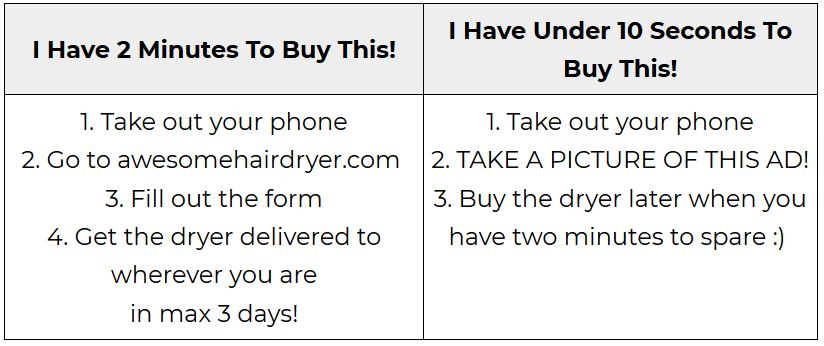
When done correctly, marketing campaigns bring the right prospects into your sales funnel and effectively raise awareness around your brand, product, and service.
The opposite is also true. When done wrong, marketing campaigns will bring you the wrong prospects and you could end up wasting time, money, and resources on ineffective marketing strategies.
Here are 5 common marketing mistakes to avoid to keep your business on the right track.
Mistake #1:
Focusing on The Product/Service Instead Of The Client
Don’t
Many companies make this critical mistake in their marketing communications: they turn the spotlight on their products instead of their customers.
To effectively deliver value to your audience, you need to understand your market.
There’s nothing wrong with presenting your product features and showcasing the awards you’ve won. But what’s going to convert your leads into paying customers is whether or not your messaging clearly presents your product as THE solution to their problems.
Let’s say your product is a hair dryer. An ineffective campaign will advertise the hardware itself, its power, its air intensity, its manual features, and so on.
Or let’s say you’re selling software services and your focus is on technical aspects, such as the programming language and hosting server. At the end of the day, that’s not what customers care about.
When I use Uber to get from A to B, I don’t care about what technology the app is using. I care about how quickly the car is going to pick me up, and that it’s going to be a smooth and comfortable ride.
Do
Having an outstanding product isn’t enough. Instead of focusing on the product itself, focus on how it helps the client. Do your research.
Find out what their real pain points (or goals) are. And then ensure all your marketing efforts tell the story of how your customers will get exactly what they want most.
If your advertising content isn’t in line with their needs, people won’t buy your product.
Let’s rethink our message for promoting the hair dryer. If, for example, your product marketing strategy focuses on saving your customers’ time by drying their hair in record time, then you’re showing consideration to the client’s pain points.
Imagine your hair dryer clients are super busy people and hate drying their hair because it takes so long. They dream of having their hair dry in under 60 seconds. A bad marketing message would say: “Our dryer has 5kW”. A better message might say “Dry your hair in under 47 seconds.”
If you’re a software solutions company, tell people “100% of the software we build is delivered on or before our client’s deadline, without skimping on quality”. See how you’re differentiating by focusing on their pain points: timeline, budget and getting their money’s worth?
Mistake #2:
Not Defining Your Unique Selling Proposition (USP)
Don’t
How do you stand out from your competitors? Why should people choose your product or service over others?
Unless you’re aware of and actively highlighting your USP in all communications with your customers, you’re not giving them a good enough reason to buy from you.
Don’t simply rely on product features, define what makes you different. And when we say different, we mean unique. As in, if you benchmark yourself against 100 competitors, you might find perhaps 2 of them that propose a similar benefit.
For example, nowadays almost every mid-range hair dryer is high quality and you can bend the handle so it becomes portable. Highlighting these features and benefits are unlikely to convince customers your product is better. So what can you do?
Do
Articulate your unique value proposition very clearly. What if your hair dryer runs on batteries AND when it’s plugged in it charges the batteries that are in it AND as an extra bonus it has 2 chargeable batteries included?
If you look around at your competitors and no one else does it – that’s your USP.
Following this example, your messaging becomes “One of the worlds’ most portable and quick-drying hair dryers”. That’s an attractive message to anyone who travels a lot and needs a hair dryer that can be carried around.
If you don’t have or can’t think of a true USP, you’ll have to compete on either price or convenience. You need to be either cheaper or more convenient to buy than other similar products/services.
Let’s say going to the supermarket to buy a hair dryer takes time. But if you go door to door, show people your product (which is almost the same as in any store), they might buy it from you simply because you’re right there and it’s convenient for them to do so. Location should always be part of your marketing strategy.
We don’t suggest you focus on price. However, if you intend your product to become a commodity and sell in high volumes, then that’s your USP. It could mean reducing prices or offering the best quality product at the lowest price.
Mistake #3:
Not Knowing Your Target Audience Well Enough
Don’t
Intuition may be a useful tool in business. However, when it comes to your marketing efforts, you shouldn’t base your decisions on gut feeling. Keeping “your options open” in terms of potential customers — thinking you can appeal to everyone — leads to wasted resources on ineffective marketing.
Do
The only way you can define people accurately is to get to know them. And what better way to get to know them than actually speaking with them? Surveys are of course useful tools for market research as well, but we found that personal 1-1 interactions work best.
This isn’t something you should try to scale. Ten 1-1 conversations where people open up and you can ask personal questions will give you much more information than 1 group meeting where you ask 20 people at a time.
You can engage in conversations with people and ask questions such as:
“Would you be interested in such a product?”, or
“How much would you be willing to pay for something like this?”
If you get to know the people you speak with, who they are, what they do, what their pain points and aspirations are, this will guide an effective marketing strategy.
Just the other day, a client of ours who provides holistic therapy services, was given an offer to advertise at a local golf club. How will they know if that will be a successful marketing strategy/investment or not?
What they need is to get acquainted with their main target audience; know their gender, age range, income, profession, pain points, what they search on the internet to fix their problems, the groups they hang out in, what they do in their leisure time, etc.
You need to go granular. Once you know your audience well enough and you align all your marketing efforts towards attracting your target audience, the right prospects will start coming through the door.
Continuing our previous example, if our holistic therapy client does their marketing research well and learns that many of their clients like to golf, then we know that’s a good investment.
Or coming back to the hair dryer example, let’s say you’ve done your research and concluded that the people who buy your hair dryers are big on traveling and have packed agendas. This means you’ll find them in airports, running around in a hurry to catch their next plane.
They won’t have time to go through an on-site checkout process. So what can we do? We put up a big ad with clear instructions on exactly what to do to order the dryer online and have it shipped to wherever you want. You can be creative and have something like:

You can tell them to access a quick link, scan a QR code, or even prompt them to take a picture of your ad in case they need to run. This way, even if they don’t make a purchase right away, they’ll have your product information stored on their phones and will likely remember you.
Play around with your advertising and marketing collateral. Make them fun. We do this in our marketing materials all the time for our own products and for the products of our clients.
Mistake #4:
Not Focusing on The Right KPIs
Don’t
For example, a bad KPI to focus on for most businesses is # of Likes on social networks. If anyone looks at our Facebook page, they will notice we have very few likes.
At the same time, Wesrom has been growing 50-200% year over year for the past 4 years! And that’s because our marketing team knows 1$ is 100x better than 1 Like.
Do
What would be a better KPI to measure? We believe it’s the triad: money in the bank, conversion rate and traffic, in the order of their importance. The moment you have those metrics figured out, you can start looking at ways to enhance your performance.
How do you make more money? You can sell more products to more unique people, you can sell to the same people more often, or you can increase your prices.
How do you increase your conversion rate? Content can be very well written and still not help you convert people to buy your product or service.
One solution is to reference your product here and there to engrain it better into your audience’s mind.
Another solution is to use Calls-To-Action (CTAs) – which most businesses don’t – to empower your readers to buy from you or hop on a call. CTAs should be part of every single piece of content that you put out there.
Whether it’s an ad, an e-book, a blog post, or a guest post, it should contain a CTA to move the target customer to take action.
How do you increase traffic? SEO techniques, social media, guest posts are all ways to help get more visitors to your blog or website. The more traffic you send to your website the more sales you have.
Mistake #5:
Not Measuring The Effectiveness of Your Marketing Efforts
Don’t
So many businesses are guilty of this. You’d think that after spending thousands of dollars on marketing campaigns, they’d put more thought into measuring the impact of their efforts. In fact, companies think they’re measuring results, but they’re not, really.
To make sure that you’re getting your money’s worth in terms of advertising and to optimize your ROI, it’s vital that you quantify your results.
Can you track them back to a specific effort? If you can, you’ve nailed it! If you can’t, it’s nothing more than an assumption.
Do
Let’s say you’ve made more sales this month. You should be able to attribute this result to a specific marketing effort. You need to know what’s working, and what isn’t.
There are many tools you can use to get quantitative insights into the performance of your campaigns.
Once you understand what works for you and what doesn’t, you can double down on what works to maximize your success.
